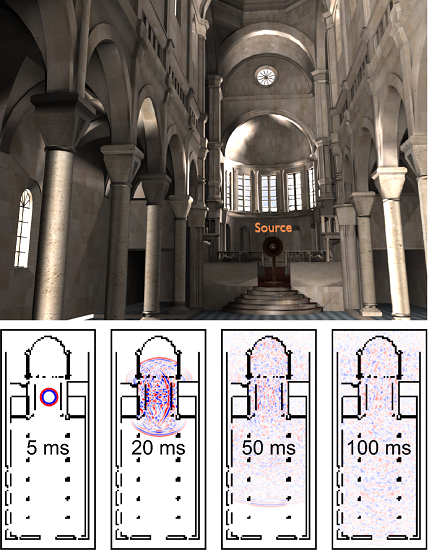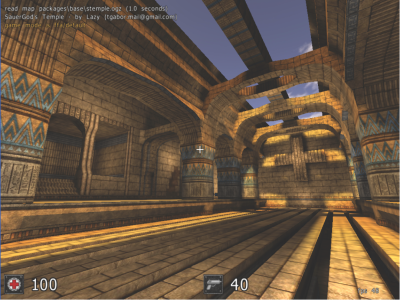Efficient and Accurate Numerical Simulation of Sound Propagation in 3D using Adaptive Rectangular Decomposition
A new approach demonstrating the feasibility of performing accurate sound propagation simulation on large environments in 3D.
Nikunj Raghuvanshi Rahul Narain Nico Galoppo
and Ming C. Lin
Email: {nikunj, narain, nico, lin} AT cs.unc.edu
Department of Computer Science,
The University of North Carolina at Chapel Hill
ABSTRACT
Accurate sound rendering can add significant realism to complement visual display, as well as facilitate acoustic predictions for many real-life applications. In this work, we present a technique which relies on an adaptive rectangular decomposition of a 3D scene to enable efficient and accurate simulation of sound propagation in complex virtual environments. It exploits the known analytical solution of the Wave Equation in rectangular domains and is thus able to achieve at least an order of magnitude performance gain compared to a standard Finite Difference implementation, while also being memory-efficient. Consequently, we are able to perform accurate numerical acoustic simulation on large, complex scenes in the kilohertz range which, to the best of our knowledge, has not been previously done on a desktop computer. This work offers accelerated computation of accurate sound propagation for large scenes on commodity hardware, enabling realistic auditory display for virtual environments and accurate acoustics analysis for architectural design
Video
A video of our technique on large scenes (WMV)
A video of an older version of our technique on smaller scenes (AVI)
Results
Note: Click on the images to enlarge.
Efficiency: Sound simulation on a Cathedral. The dimensions of this scene are 35m x 15m x 26m and it contains 11.9 million simulation cells. We are able to perform numerical sound simulation on this complex scene on a desktop computer and pre-compute a 2 second long impulse response in 15 hours, taking 1.5GB of memory. The auralization, or sound rendering at runtime consists of convolution of the calculated impulse responses with arbitrary source signals, that can be computed efficiently. A commonly used approach that we compare against, FDTD, would take 2 weeks of computation and 25GB of memory for this scene.
Efficiency: Sound propagation simulation in a game environment. The volume of this scene is more than 800 meter cubed, which corresponds to about 300,000 cells. Our simulator enables realistic interference, diffraction and reverberation sound effects in 3D, taking about 25 minutes to produce 1 second of audio on this scene, for frequencies up to 1 kHz.
Effect of Room Size on Sound: The physical dimensions of the map are 12m×13m×7m and has about 300,000 cells. We partition the space in the room into into 300 partitions, containing roughly 1000 cells each. We are able to perform simulations for frequencies upto 1kHz on this map. The listener is at the player's location. Note that the input sound (shown on top) is modified considerably by the environment depending the size of the space (small or large respectively). Also note that the frequency content of the input signal is effectively filtered depending on the size of the area of the map where the listener is located. Note the "reverberant tail" in both the simulated sounds, which lasts after the input sound has subsided (you may need to click on the image to see this clearly).


